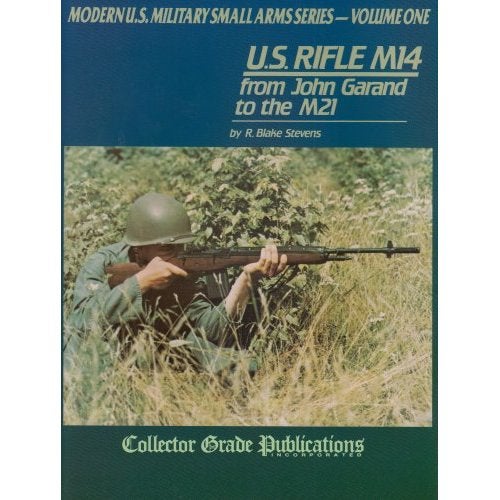As in all Small Caliber Book Reviews here at TFB, I will be covering the area of relevance and strengths and weaknesses of the book, as well as whether it is more introductory or advanced.
The recent mud and sand tests of the M14 by InRange TV have blackened the eye of that rifle somewhat, but rather than dismiss it as unreliable and bad, I think it’s better to try to understand the history of the design, and if it is substandard, why. That’s why the subject of this review will be the Collector Grade volume U.S. Rifle M14 – from John Garand to the M21 by R. Blake Stevens, possibly the seminal piece of research regarding the M14 rifle.
Besides being essential to understanding the story of the M14, U.S. Rifle M14 is also a good source of information regarding the wartime and post-war modifications made to the M1 Garand rifle (from which, of course, the M14 is directly derived), as well as the abortive T25/T47 rifle, designed by Earle Harvey. The book does not cover in detail the “caliber wars” of the late forties and first years of the 1950s, nor does it provide much information on foreign developments, or the US development of the FAL/T48 rifle. It is essentially concerned only with design and development within Springfield Armory itself, as well as the trials and tribulations of the M14 program as a whole.
This latter aspect is the book’s primary strength. The story of the M14 is a sordid one (though not, I note, as strictly depressing as that of the L85 as covered in a book by the same publisher). The rifle’s genesis lies in a man’s extreme ego and unwillingness for the US to have anything but a US-designed rifle (producing the next US service weapon anywhere but in the US was never in question; FN even gave the US government full rights, royalty free, to produce the FAL anywhere in the United States for military purposes), and its birth and the five years it took to bring the rifle to production – production which lasted only four years – represent one of the biggest fiascoes in US small arms history. Secretary of Defense Robert McNamara, in an almost definitive example of his characteristic tendency to get to the heart of a problem without really understanding it, said in 1961: “I think it is a disgrace the way the project was handled. I don’t mean particularly by the Army, but I mean by the nation. This is a relatively simple job, building a rifle, compared to building a satellite or a lunar lander or a missile system.”
The final section of the book covers the M14’s transformation, after its service life as a standard infantry arm was done, into a precision weapon. The challenges involved in doing so with a weapon that – far from not being designed for the precision rifle role – seemed designed almost explicitly to preclude the possibility of it being used in that manner at all, are fascinating to read about, and the fact that the rifle was eventually used successfully in this capacity speaks to the herculean effort behind it.
While U.S. Rifle M14 deals with a lot of technical detail, I think it appeals to more than just the fastidious student of small arms history during the period. In particular, I think the book would also appeal to anyone tangentially familiar with small arms, but very familiar with government procurement programs. Anyone who has had to wade through the bureaucracy of US government in an effort to get something produced and fielded, or who had to deal with a product that was either unsuitable or pushed through before it was mature, would probably find themselves nodding their head along with U.S. Rifle M14 as they read the story of a program than stumbled more than it ran, and finally was swept aside by dramatic reorganization of the bodies that were responsible for it.
U.S. Rifle M14 – from John Garand to the M21 is available on Amazon for $75.00 US, which is about typical for a Collector Grade Publications title.
 Your Privacy Choices
Your Privacy Choices
